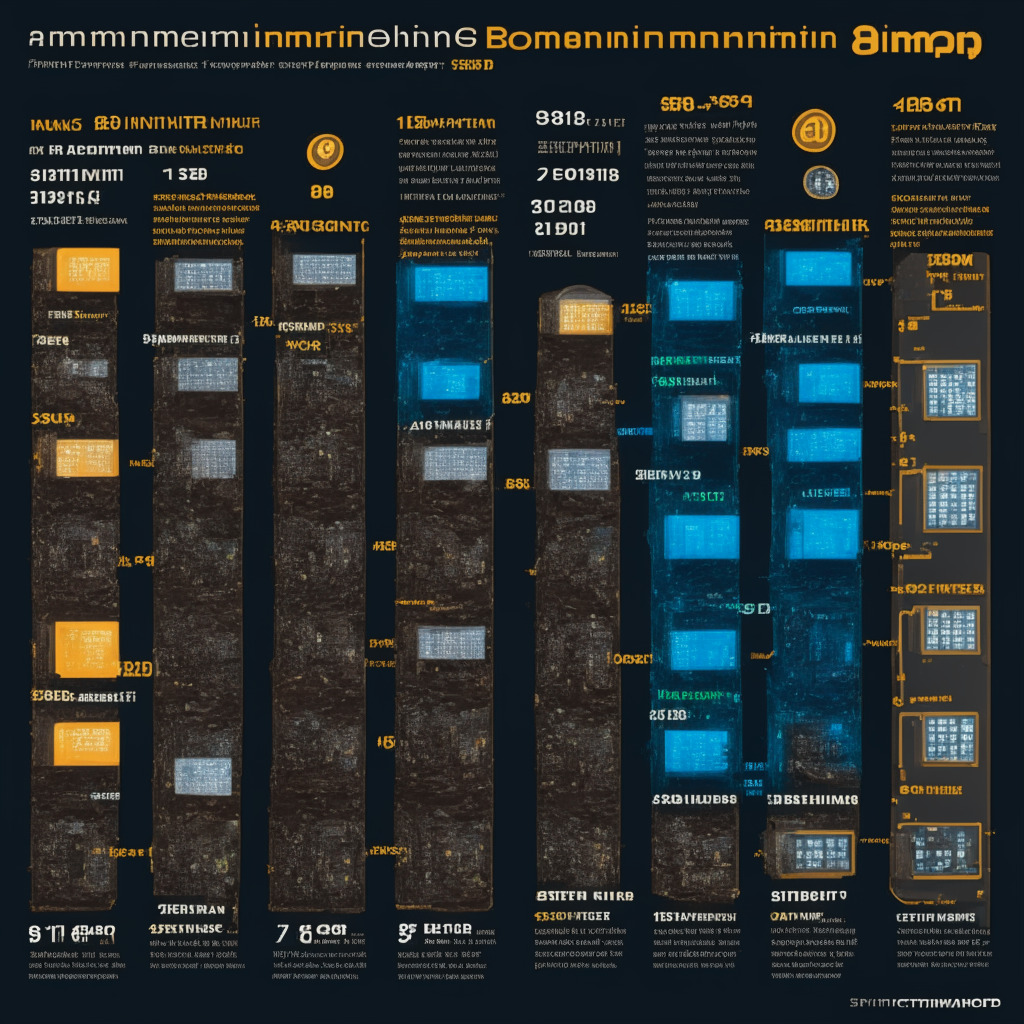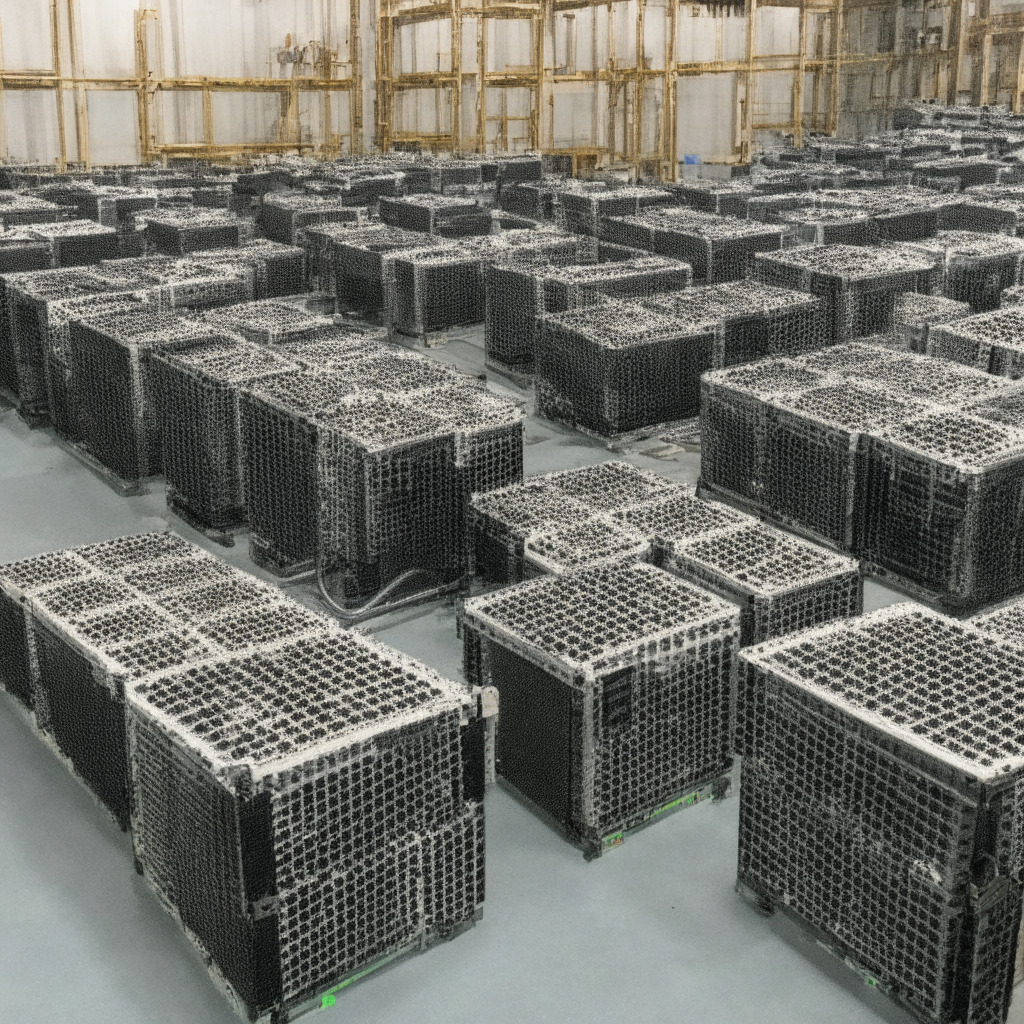“Cryptocurrency mining involves solving complex mathematical problems known as hashing. Currently, Texas leads in Bitcoin’s hash rate in the U.S. with 28.5%. Interestingly, the state’s regulatory framework and favorable energy prices make it ideal for crypto miners. Despite burgeoning operations, energy consumption, power curtailment, and regulatory policies shape the future of cryptocurrencies.”
Search Results for: Bitcoin mining machine
Unearthing Hidden Bitcoin Mines in Venezuelan Prisons: Economic Boon or Bane?
In a recent Venezuelan police operation, undisclosed Bitcoin mining activities were discovered within a notorious prison. This reflects the growing popularity of crypto mining in the country, despite authorities’ efforts to curb these activities due to their high power demand and resultant socio-economic complexities. The event highlights the conflict between security, sustainability, and economic growth in the crypto realm.
Predicting Bitcoin’s Surge: 2024 Halving, Supply Deficit, and the $100,000 Milestone
Davis Hui, VP of Canaan, predicts that the upcoming Bitcoin halving could push the coin’s value beyond $100,000. This is due to the expected supply deficit and increase in institutional adoption. However, high hash rates and network difficulties might force some miners to quit, potentially leading to a further decrease in Bitcoin supply. Concurrent technological partnerships between the United States and Vietnam in AI, cloud computing, and semiconductors indicate a shift towards a more tech-integrated global future.
Unmasking Crypto-Mining Attacks: Hackers, Graphic Design Tools, and the Art of Stealth Mining
Cisco Talos Intelligence Group found hackers use a Windows tool, Advanced Installer, to package malicious crypto-mining code with software installers of common design tools. Affected computers become carriers for malware miners, their powerful GPUs exploited to mine cryptocurrencies on behalf of the hackers, indicating increasing intersection between technological evolution and cybersecurity threats.
Debunking the Myth: The Real Energy Consumption of Bitcoin Mining
“The Bitcoin Electricity Consumption Index (CBECI) has significantly adjusted its original estimates of cryptocurrency’s energy appetite. It now suggests Bitcoin network’s total energy consumption is more comparable to US tumble dryers usage. This shift is due to the realization that older mining machines are being decommissioned quicker than predicted.”
Lone Bitcoin Miner Strikes Gold: Examining The Underdog Win in Crypto’s Expansive Arena
On August 18, a solo Bitcoin miner, with an estimated hash power of 1 PH/s, successfully claimed the complete reward of 6.25 Bitcoins for solving block 803,821 using Solo CKpool mining service. This relatively low-power miner striking it big, despite the dominance of behemoth mining pools, emphasizes the importance of platforms like Solo CKpool that provide opportunities for individual miners.
Hydro-Powered Bitcoin Mining: Pioneering the Green Crypto Future or Exacerbating Energy Woes?
Bitcoin mining is moving towards renewable energy, with Genesis Digital Assets Limited opening a hydroeletricity-powered data center in Sweden. This reflects a trend, proving that Bitcoin mining and clean, renewable energy can coexist, which potentially addresses the industry’s environmental concerns.
Blockstream’s Big Bet: Investing $50M in Undervalued ASIC Mining Gear Amid Bitcoin Recovery
“Blockchain firm Blockstream plans to raise $50 million for the bulk purchase of undervalued ASIC mining equipment. Partnering with STOKR, they aim to launch the Blockstream ASIC Note, with most investments expected in Bitcoin. This strategy indicates a promising future despite the declining price of ASIC miners and Bitcoin’s recent price recovery around $30,000.”
Harnessing Green Solutions: How Bitcoin Mining Could Drive Us Towards A Carbon-Neutral Future
“Bitcoin mining’s energy consumption has raised environmental concerns. However, recent innovations like flare gas solutions and nuclear energy are promising enhancements. Harnessing flare gas, an underused resource, for mining operations could drive a carbon-neutral era. Further potential lies in microgrids and nuclear power, despite safety and regulatory concerns. All these seek to incentivize blockchain use beyond Bitcoin mining, significantly reducing the industry’s carbon footprint.”
The Rise and Fall of Bitcoin Mining Titans: Marathon Triumphs as Core Scientific Stumbles
“Marathon Digital Holdings has become the world’s lead bitcoin miner, surpassing Core Scientific with its self-mining hashrate or computational power. Despite setbacks, Marathon’s rapid adaptability and growth has resulted in nearly tripling its operational hashrate and a 360% stock price surge in 2023.”
Unraveling Russia’s Bitcoin Mining Boom: Economic Incentives and Geopolitical Pressures
Despite international sanctions following Russia’s invasion of Ukraine, the country’s bitcoin mining industry is booming due to low-cost energy and a cold climate. However, businesses operating there face risks including prohibited associations with sanctioned entities and potential reputational damage. Interestingly, this doesn’t discourage foreign companies; Russia’s economic advantages and Ordinals project-enhanced blockchain activity keep improving the country’s mining conditions.
Navigating the Bitcoin Halving: A Crossroads for Miners Between Efficiency and Survival
“The expected Bitcoin halving event in April 2024 could cause a 30% drop in Bitcoin’s computational force, potentially making mining unprofitable for many. Miners could mitigate this by deploying new-generation machines that require less power, thus reducing operating costs.”
Bitcoin Mining Rig Market Value Crisis: Adaptation or Extinction?
Bitcoin mining rigs are witnessing a significant decrease in market value due to lower profitability and higher energy costs. Next-gen rigs like Bitmain’s S19 XP and WhatsMiner M50S saw a 66% price drop. However, these falling prices may benefit miners preparing for the upcoming Bitcoin halving in 2024, potentially spurring a shift towards more efficient machines.
Redefining the Bitcoin Energy Monster: Role of ASICs in Boosting Efficiency and Profits
“Bitcoin’s perceived high energy usage could be overstated due to significant increases in mining efficiency over the past five years, notably with ASIC miners. Coin Metrics’ revealed a 63% reduction in energy usage for comparable work, highlighting a shift in energy consumption narrative and potential for higher miner returns.”
Unveiling the Pros and Cons: SEC Scrutiny, Bitcoin as a Commodity and the Future of Crypto Regulation
The SEC’s regulatory scrutiny towards crypto is seen by some as strengthening Bitcoin’s market position. Classification of Bitcoin as a commodity rather than a security is due to its decentralised structure, eliminating capital collection for future returns. Despite its commodity classification, Bitcoin can feature in contracts resembling securities. This regulatory landscape highlights the need for careful navigation amid increased crypto regulation.
Navigating Rough Seas: The Dynamics, Challenges and Future of Bitcoin Mining in a Bear Market
“Bitcoin miners experienced a $184 million windfall from transaction fees in Q2 2023 following a flat 2022. Top public mining companies saw their market cap increase by 257% since early 2023. However, miners are also liquidating Bitcoins to cover operational costs, due to scarcity of external capital and an ongoing bear market.”
Unearthing Bitcoin’s Energy Efficiency: A Tale of Progress and Ongoing Challenges
“Coinmetrics reports highlight a noteworthy enhancement in Bitcoin network’s energy efficiency by about 60% since July 2018, due to the arrival of superior, more efficient machines. Additionally, CoinShares’ research indicates that a substantial 74.1% of Bitcoin mining energy originates from renewable sources.”
Significant Improvements in Bitcoin’s Energy Efficiency: Promise or Peril?
Bitcoin’s energy efficiency has improved by about 60% since 2018 due to more efficient mining systems. This gain in efficiency is critical as concerns rise about the environmental impact of Bitcoin mining activities. This progress is matched with a trend towards sustainable energy sources, with 74.1% of Bitcoin’s mining power now coming from renewable energy sources.
Navigating the 2024 Bitcoin Halving: Opportunities and Challenges for Crypto Miners
This article discusses the upcoming Bitcoin halving in 2024, which could pose significant challenges for miners due to rising electricity costs and declining mining rewards. Despite the potential pitfalls, resilience defines this industry as miners strategize to safeguard themselves against halving impacts. The sector’s ability to navigate this path will determine the long-term stability of the crypto ecosystem.
Supercalculating the Future: AI, Blockchain, and the Surprising Resilience of Bitcoin Miners
Applied Digital Corporation (APLD) notably ventured into AI as its third business initiative, gaining attention for its strategic partnership with Hewlett Packard Enterprises (HEP) for the use of HPE Cray XD supercomputers. This partnership hopes to enhance APLD’s AI cloud service, potentially generating around $820 million over the next three years and compensating for the decrease in bitcoin prices.
Riot Platforms’ Massive ASIC Order: Revolutionizing Bitcoin Mining or Threat to Sustainability?
Riot Platforms acquires 33,280 mining rigs from MicroBT, increasing its hashrate capacity to 20.1 EH/s. The machines, designed for immersion cooling systems, will be deployed by Q1 2024. This groundbreaking development occurs as questions about optimizing efficiency and addressing environmental concerns in the mining industry arise.
El Salvador’s Bitcoin City Airport: Promising Innovation or Harmful Disruption?
El Salvador’s Bitcoin City project is progressing, with the construction of Pacífico Airport (Bitcoin City Airport) underway. Utilizing geothermal power for energy, the government envisions a tax-free, BTC-oriented environment. However, concerns regarding environmental impact, community relocation, and risk remain, highlighting a complex reality in pursuing a blockchain future.
Merging Giants: Hut 8 Mining & US Bitcoin Corp to Form $990M North American Crypto Powerhouse
Bitcoin miners Hut 8 Mining and U.S. Bitcoin Corp plan to merge, creating a $990 million North American crypto mining giant, Hut 8 Corp. The merger aims to expand revenue, adopt a diversified business model, and capitalize on their financial position.
CleanSpark’s $9.3M Georgia Facilities: A Step Towards Crypto Mining’s Sustainable Future
CleanSpark has agreed to purchase two ready-to-use mining facilities in Dalton, Georgia for $9.3 million, adding nearly 1 exahash per second capacity to its fleet. This acquisition aims to exceed the company’s year-end target of 16 EH/s, positioning CleanSpark as one of the most power-efficient miners concerning energy-per-hash rate.
CleanSpark’s $9.3M Expansion: Mining Efficiency vs Uncertain Profitability in Bitcoin Industry
Bitcoin mining firm CleanSpark acquires two mining sites in Georgia for $9.3 million, aiming to achieve a 16 exahash per second (EH/s) hash power target by 2023. The acquisition contributes to a 15% increase in computing power, positioning CleanSpark as an energy-efficient miner. However, long-term profitability amidst market challenges remains uncertain.
Is Bitcoin Mining Worth It? Evaluating Profitability vs. Direct Investment in Crypto
Research suggests that buying Bitcoin (BTC) directly is often more profitable than mining it at home due to labor-intensive and costly processes. Bitcoin miners are only profitable if they recoup 100% of capital spent on equipment, excluding operational costs. However, mining can be a profitable venture for those with access to low electricity prices.
Decoding Bitcoin’s Energy Use: New Method for Accurate Estimations and E-Waste Impact
The Coin Metrics report examines Bitcoin miners’ energy consumption by analyzing blockchain data, offering more accurate estimates compared to previous studies. Incorporating hardware efficiency and e-waste, it facilitates more robust, data-driven discussions about Bitcoin’s environmental impact and future decision-making in crypto mining.
Bitmain Mining Rigs Claim 76% of Bitcoin’s Hashrate: Decentralization & Energy Efficiency Debate
Recent research by Coinmetrics reveals that three Bitmain mining rig models hold a 76% share of Bitcoin network computing power, highlighting energy efficiency’s role in modern mining. The report also shows a 60% improvement in the network’s energy efficiency since July 2018, with 33.6 joules per terahash consumed today compared to 89.3 J/TH in 2018.
Defying the Odds: Solo Bitcoin Miner Solves Block, Wins $160K with Antminer S9 Rig
A solo bitcoin miner recently defied the odds, solving block 793,607 using a single Antminer S9 rig and earning a reward of 6.175 BTC ($160,100). This impressive feat would typically occur only once every 450 years on average, highlighting the potential rewards of perseverance and dedication in the crypto mining world.
Bitcoin Halving 2024: Survival of the Fittest Miners and the Impact on Crypto Industry
The upcoming Bitcoin halving in April 2024 will force miners to optimize and adapt strategies to remain profitable, as block rewards are slashed to 3.125 BTC. Post-halving mining costs may double, making energy costs and equipment efficiency vital for miner survival.
Marathon’s 77% Bitcoin Mining Surge: Proprietary Software or Untapped Capacity?
Bitcoin miner Marathon Digital Holdings experienced a 77% spike in their Bitcoin mining production in May, attributed to its proprietary software, an increased hash rate, rising transaction fees, and the growing popularity of Ordinals protocol. However, maintaining a balanced perspective and managing expectations is advised.
Bitcoin Miners’ Dilemma: Liquify Assets or Hold for Higher Gains?
Matrixport’s research reveals shrinking profit margins may be forcing Bitcoin miners to sell their newly mined inventory. Increased mining difficulty and unprofitability of older machines contribute to this pressure, raising questions on the sustainability of high gains in the longer term.































